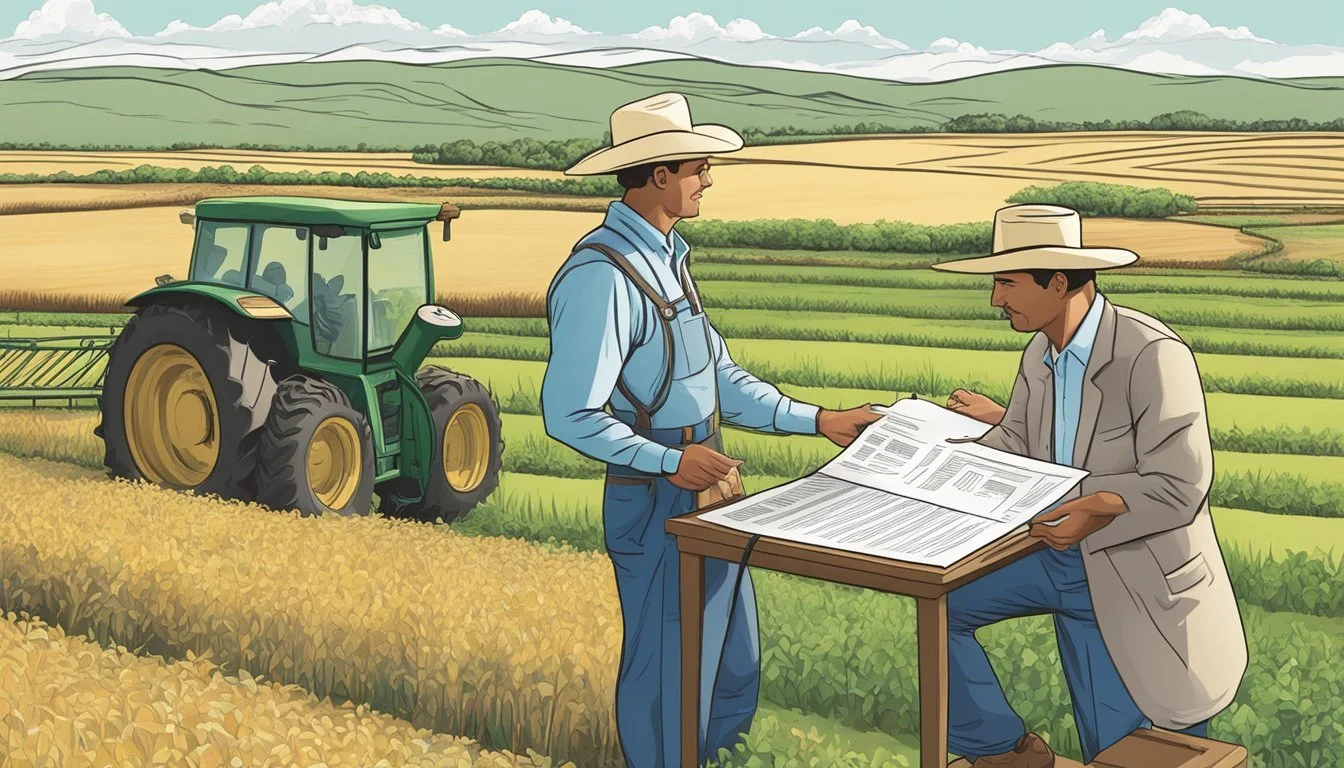New Mexico Farm Land for Lease
Opportunities and Options
This Article is Part of Our Guide on Navigating Agricultural Leases Across the US
In recent years, the trend of leasing farm land has become increasingly prevalent in the United States. New Mexico, with its vast and varied agricultural landscapes, offers ample opportunities for individuals and businesses seeking to lease farm land. The state's unique climate and geography make it an attractive location for various types of farming, from traditional crops to more specialized ventures.
Farm land for lease in New Mexico spans a wide range of properties, including expansive ranches, irrigated farmland, and high-elevation acreage suitable for a variety of agricultural uses. Potential lessees can find land with the necessary amenities for successful farming operations, such as water rights, fencing, and access to roads. Moreover, New Mexico's land leasing market caters to different needs, from large-scale commercial farming to smaller organic productions.
The leasing process in New Mexico is designed to be transparent, offering clear terms and conditions to both landowners and lessees. Interested parties are encouraged to consider factors like lease duration, land quality, and available resources when looking into farm land opportunities in the state. By entering into a farm land lease, lessees gain the chance to operate on New Mexico's rich soils without the upfront costs associated with purchasing property, allowing both new and experienced farmers a means to cultivate and contribute to the state’s agricultural industry.
Understanding Agricultural Leasing in New Mexico
Agricultural leasing in New Mexico comprises various legal agreements, principally aimed at the utilization of land for farming and ranching on privately owned and state trust lands.
Types of Agricultural Leases
Agricultural leases in New Mexico fall into distinct categories, delineated by their use and terms. The primary types of leases include:
Crop cultivation leases, allowing for the production of crops.
Livestock grazing leases, designated for the raising of animals.
Timber production leases, focusing on the harvest of timber resources.
Each lease type dictates specific terms concerning the lease period, use of the land, and stewardship expectations.
State Trust Lands and Lease Opportunities
State trust lands present unique lease opportunities for agricultural purposes. The New Mexico State Land Office administers:
Over 3,500 leases on state trust land.
Annually, about 600-900 leases are due for renewal.
Operators interested in these leases are subject to a competitive process, ensuring the land’s productive use in harmony with other land interests, including conservation and public resource management.
Lease Rates and Financial Considerations
In New Mexico, the lease rates and financial benefits of leasing farmland are key considerations for both landowners and farmers. These factors largely dictate the tenability and profitability of agricultural activities in the region.
Determining Lease Rates
Lease rates for farmland in New Mexico are influenced by a variety of factors, including land quality, location, and current market demand. As an example, over a 20-year period, farmland rental rates have seen a notable increase, which reflects the changing economic landscape of agricultural production in the state. To calculate the current lease rate per acre, one should consider the land's capability to produce, the average rate in the locality, and any amenities included in the lease.
Example Lease Rate Increase: From $0 per acre to $0 per acre in 2019
Capitalization Rate: Average implied rate of 0%
Financial Benefits of Leasing
Leasing offers several financial benefits for landowners and farmers. Landowners receive a steady income stream without the need to actively manage the farmland, while farmers may benefit from access to additional acreage for expansion without the upfront costs associated with purchasing property.
For Landowners: Steady income, lower management needs
For Farmers: Access to land, reduced capital expenditure
By examining these components closely, stakeholders can make informed decisions regarding the leasing and utilization of agricultural land in New Mexico.
Legal Aspects of Leasing Farmland
Leasing agricultural land in New Mexico involves several legal considerations that are crucial for both the landowner and the lessee to understand. These considerations ensure that the arrangement is mutually beneficial and legally compliant.
Understanding Lease Agreements
A lease agreement is a binding contract that details the terms under which farm land is rented. Specifically, in New Mexico, the lease sets out the rights and obligations of the landlord and the tenant regarding the use of the land for agricultural purposes. It includes detailed aspects such as land use, lease duration, payment terms, and any restrictions on the property.
Payment Terms: Lease agreements must clearly state the rental rate, which could be a fixed amount or based on production.
Land Use: Tenants are generally allowed to use the land for crop cultivation, livestock grazing, or other agreed-upon agricultural activities.
Assignment and Transfer of Leases
The ability to assign or transfer a lease is critical to a lessee's operational flexibility.
Assignment Clauses: Most leases contain provisions regarding the assignment or transfer of the lease to another party. Typically, assignment requires the consent of the landowner.
Succession Rights: Provisions regarding the passing of lease rights in case of the lessee's death may be included.
Lease Renewals and Terminations
The longevity of a farming operation often depends on lease durations and the terms under which a lease may be renewed or terminated.
Renewal Terms: Leases may have specific clauses that discuss the conditions under which a lease may be renewed, generally involving notice periods and terms negotiation.
Termination Clauses: Circumstances under which a lease can be terminated prematurely should be outlined, along with associated notice periods and any penalties.
Understanding these legal aspects helps protect the interests of both parties in agricultural leasing and promotes a successful, long-term farming operation.
New Mexico Land for Agricultural Use
New Mexico offers diverse opportunities for agricultural leasing, with lands designated for crop production and livestock grazing. These activities are vital for the state's economy and are managed to ensure sustainability and efficiency.
Crop Production and Farming
In New Mexico, crop farming plays a critical role in the state's agriculture, with cotton being one of the significant crops produced. The NM State Land Office manages numerous agricultural leases, which include land savvy for crop production. 8.9 million acres of state trust land are overseen by the Agricultural Leasing Bureau, with a portion allocated to crop production. The state's climate and soil conditions are conducive to growing various crops, including cotton, which is vital to the textile industry. The lease fees for these lands are established following specific formulae managed by local authorities, such as New Mexico State University, to align with market values and ensure fair practices.
Livestock and Grazing Lands
Regarding livestock, New Mexico's rangelands offer extensive areas for grazing. The Bureau manages over 3,500 agricultural leases, which include leases for livestock grazing, reflecting the importance of this sector. Each year, between 600-900 leases come up for renewal, indicating the dynamic nature of land use and management in the state. Lease agreements can either be released by the current lessee or assumed by a new lessee, with conditions to protect both the land and interests of the parties involved. Livestock grazing fees are recalculated annually, ensuring that the costs reflect the current economic environment and provide support for the agricultural framework within New Mexico.
Wildlife and Environmental Considerations
In New Mexico, the intersection of agriculture and wildlife centers on managing the land to support deer populations and understanding the impact of farming practices on forests.
Managing Land for Deer Populations
A key species affected by land management is the mule deer. These animals rely on natural habitats that sometimes overlap with agricultural areas. Effective land management for mule deer populations includes:
Habitat Conservation: Maintaining patches of native vegetation and undeveloped land is essential for providing food resources and shelter for deer.
Water Sources: Ensuring access to water helps mule deer thrive, especially in the arid climate of New Mexico.
Impact of Agriculture on Forests
Agricultural activities can have various effects on New Mexico's forests, including:
Soil Quality: Farming practices can lead to soil compaction and erosion, which hinder forest growth and health.
Habitat Fragmentation: Expansion of farmland can fragment forests, impacting the ecosystem services they provide, such as groundwater recharge and maintaining clean air.
Trends and Data in Agricultural Leasing
In New Mexico, agricultural land lease trends and the utilization of data play a crucial role in shaping the state’s vast agricultural sector. Reliable data is foundational for making informed decisions, be it for farmers, investors, or policymakers.
Analyzing Market Trends
Over the past 20 years, agricultural leasing in New Mexico has evolved significantly. Recent trends indicate a steady climb in farmland rental rates. For instance, within a 20-year duration, the state has seen farmland rental rates per acre rise from an average of essentially $0 to $0 in 2019. Moreover, factors like the overall surge in farmland values have put upward pressure on lease rates, especially heading into 2022, with notable increases that outpace historical percentages.
Rental Rates: Increased from an average of $0/acre to $0/acre from 2000 to 2019.
Grazing Fees: Set annually using a formula managed by New Mexico State University.
Importance of Data in Agriculture
Agricultural data has proven indispensable, guiding leasing decisions and policy formulations. The data-driven approach, spearheaded by collaborations like that of the New Mexico State University, establishes grazing fees and ensures a competitive yet fair pricing structure. State trust lands, encompassing over 8.9 million acres for livestock and crop production, require meticulous management to foster sustainability and economic viability.
Lease Management: Over 3,500 leases managed with 600-900 renewals annually.
Acreage: 8.9 million acres of state trust land are issued for agricultural purposes.
Utilizing accurate and comprehensive agricultural data helps stakeholders understand and adapt to changing market conditions, ensuring economic resilience in New Mexico's farming industry.
Comparing Leasing with Buying Farmland
When considering New Mexico farmland, stakeholders must assess the financial and managerial aspects of leasing versus buying. Each route offers different benefits and responsibilities, directly impacting operation and investment.
Benefits and Downsides of Leasing vs. Buying
Leasing Farmland
Benefits:
Lower Initial Capital Requirement: Leasing farmland typically involves less upfront capital compared to purchasing, making it accessible for new or expanding farmers.
Flexibility: Lessors can often adapt to changes in market conditions with greater ease, potentially moving to more fertile or strategically located acreage as opportunities arise.
Downsides:
No Equity Building: Lease payments contribute to the landowner's equity, not the lessee's. Over time, this can represent a significant opportunity cost.
Variable Costs: Lease rates can fluctuate, depending on market conditions and agricultural demand.
Benefits:
Asset Appreciation: Owners of farmland can benefit from the potential increase in land value over time.
Full Control and Stability: Buying farmland grants full autonomy regarding its use, development, and management.
Downsides:
High Initial Investment: The cost per acre for purchasing can be substantial, which may be prohibitive for some farmers.
Long-Term Commitment: Owners are responsible for all the associated risks, including market volatility and real estate taxes.
Long-term Leasing Implications
Long-term leases can significantly impact both lessees and lessors. For the lessee, they provide operational stability and can foster long-term planning and investment in the land's productivity without the equity benefits of ownership. For the lessor, a long-term lease can offer a steady income stream and reduce the burdens of direct management. However, they must ensure that lease rates reflect the land's current and future value to prevent loss of potential income. Additionally, they may be limited in their ability to directly benefit from factors like government incentives for land development or conservation.
Role of County and District Resource Managers
In New Mexico, the management of farm land leases is a coordinated effort. County and District Resource Managers play pivotal roles in ensuring that the agricultural lands are used effectively and sustainably.
County-Level Management
County Resource Managers are responsible for overseeing and implementing policies related to agricultural leases within their respective counties. They ensure that land use complies with local regulations and that the interests of the state, lessees, and the community are balanced. Their specific duties often include:
Inspections: Regular checks to ensure lease compliance.
Communication: Serving as the point of contact between lessees and the state.
Counties work closely with the New Mexico State Land Office, which manages over 3,500 leases on state trust land. The symbiotic relationship ensures that all processes adhere to the state's guidelines for agricultural leasing.
Collaboration with District Resource Managers
District Resource Managers collaborate with their county counterparts to ensure regional agricultural initiatives align with broader state objectives. Their focus includes:
Resource Sharing: They facilitate the sharing of tools, expertise, and information across county lines.
Strategic Planning: District managers assist in the planning and coordination of agricultural projects, considering cross-county impacts and opportunities.
Both County and District Resource Managers are essential in striking a balance between agricultural productivity and conservation efforts, working in tandem to support the agricultural community while protecting New Mexico's diverse ecosystems.









